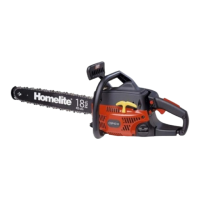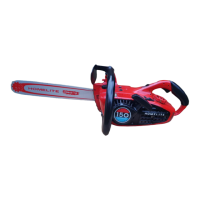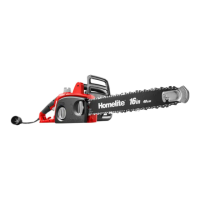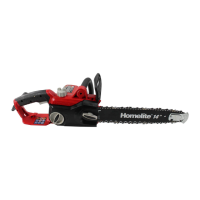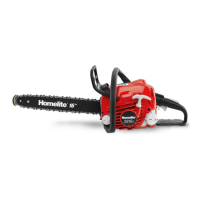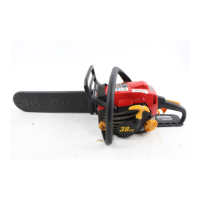4.
During starting, hold the saw down firmly on a level
surface with the bar and chain in the clear. Never strad-
dle the guide bar or lean across the saw. As illustrated,
put your left knee snugly against the engine just be-
hind the front handlebar to help steady the saw. Grip
the throttle control handle and depress the trigger with
your left hand. Pull the starter rope with your right
hand.
5.
Always keep your weight well balanced on both feet
when cutting. Since you will be exerting moderate
pressure to cut, guard against loss of balance by being
ready to hold up on the saw as it cuts through the ma-
terial. However, throttle up to full speed before letting
the chain contact the wood. AND do not throttle down
before the cut has been completed. Never cut at part
throttle, because the clutch is not fully engaged at in-
termediate speeds and will slip and burn. As soon as
the cutting load is removed, you should release the
throttle trigger to slow the engine back to idle speed.
Letting an unloaded engine race is harmful to it.
STARTING AND STOPPING
1.
Flip the ignition to the "RUN" position.
2.
Push the choke lever all the way up (for a richer mix-
ture required for a cold engine).
FULL CHOKE
HALF CHOKE
OPEN CHOKE
3. Hold the saw down and open the throttle per previous
instructions beginning on page 6.
4.
Pull the starter rope out a short way until you feel the
starter engage. Then pull rope briskly to give a fast
cranking spin. (Do not pull rope to the very end or you
may damage the starter.) Hold onto the grip during
rewinding so the rope will not snap back and become
frayed.
5.
Crank until the engine fires. Normally, an engine that
has not been run for some time requires three to five
pulls just to prime with fuel before it can fire. On the
other hand, a recently run engine will usually start up
on the first or second pull. However,
in
cold weather,
initial priming will take more pulls because an ex-
tremely rich mixture is needed.
6. A cold engine will often fire (go pop
...p op ...p op) and
then stop. This is enough to warm it so that you should
push the choke lever halfway down before continuing
to crank.
7.
When the enine starts, keep it running at half-choke
to warm it up, but flip the choke lever all the way down
before it gets so much fuel that it stalls out. Note:
Any engine which
hasfired several timesat fullchoke
will start at half choke.
8.
Now you are ready to operate. Grasp the throttle han-
dle with your right hand so that you can use one finger
on the trigger to hold the throttle open. Grasp the
front handlebar with your left hand. (Use correct
grip-see page 6.) Let the engine idle. Pick up the saw
and position yourself for cutting.
9.
Flip the switch to "STOP" position to stop the engine.
OPERATOR'S
BODY
ENTIRELY TO
LEFT OF
CHAIN
LINE
HARD HAT
EYE PROTECTION
TRIM,
PROTECTIVE ELBOW AS
STRAIGHT
AS POSSIBLE
PROTECTIVE,
NON-SLIP
HANDLEBAR
NO PANTS
CUFFS TO
UNDERBRUSH
10. To restart a warm engine (or any engine which has
fired afewtimes)
crankat half choke.Aftershort shut-
downs, the engine may be warm enough to be re-
started with out choking and with the throttle control
at idle setting.
11. Choking a warm engine may be necessary after an en-
gine has been in the hot sun or in a car trunk, or has
been shut down for five to ten minutesafter being run.
These things cause vapor to form in the carburetor. it
can be cleaned out and the saw started as follows:
Crank alternately at full
chokeand half choke until the
engine fires. Then run at half choke when engine
starts. Allow no more than 30 seconds before opening
the choke fully. If required, repeat above sequence
until engine clears itself and runs properly.
IMPORTANT
When you are through using the saw, relieve tank pres-
sures by loosening the
CHAIN OIL
and
FUEL
MIX
caps.
Then retighten the caps. For extended periods of
non-
use, prepare the saw for storage as recommended in
Section
6.

